What is a Ruptured Eardrum?
A ruptured eardrum, also known as a perforated eardrum, is a condition where there is a tear or hole in the thin membrane (tympanic membrane) that separates the outer ear from the middle ear. This membrane plays a critical role in hearing by vibrating in response to sound waves and transmitting these vibrations to the small bones (ossicles) in the middle ear.
I first noticed something was wrong when I felt a sharp pain in my right ear followed by a sudden loss of hearing and a ringing sound. The sensation was disorienting and concerning, as I had never experienced anything like it before.
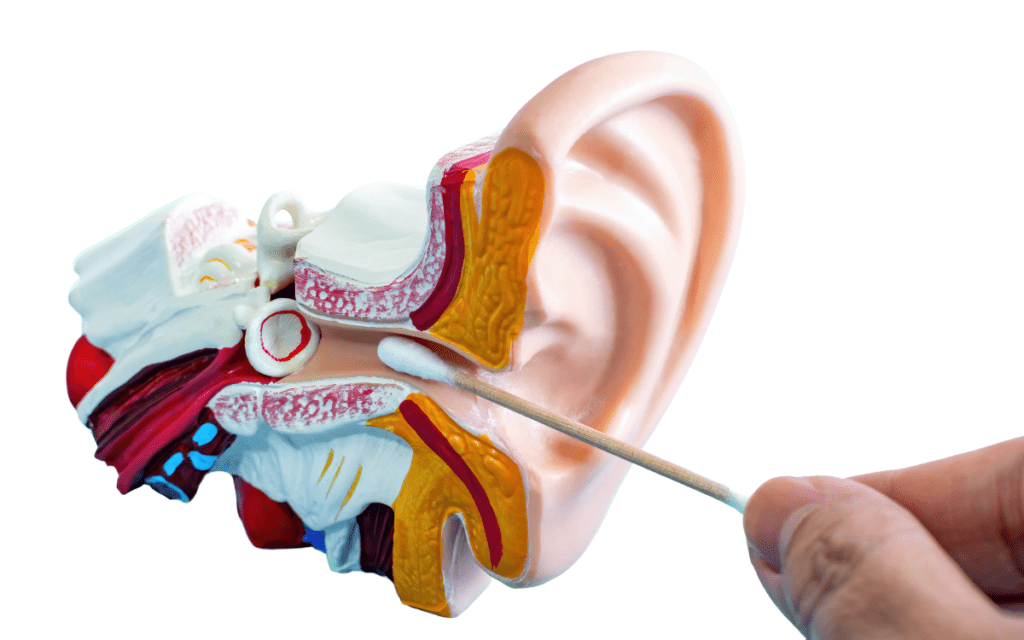
Personal Experience: My Journey with a Ruptured Eardrum
Concerned about my symptoms, I decided to visit an ENT specialist, Dr. Shailesh Jain. When I described my ear problem to him, he took several steps to diagnose the issue:
Diagnostic Endoscopy and Fibreoptic Examination of the Larynx (FOL): Dr. Jain performed a diagnostic endoscopy and a fibreoptic examination of my larynx under local anesthesia (LA). This procedure involved using a flexible tube with a light and camera to get a clear view of my ear canal and eardrum.
CT Scan of the Head Section: To get a comprehensive understanding of the situation, he also ordered a CT scan of my head. This imaging test provided detailed pictures of the structures inside my head, helping to confirm the extent of the damage.
These thorough diagnostic steps helped Dr. Jain accurately assess the condition of my eardrum and surrounding areas.
My Diagnostic Endoscopy and Fibreoptic Examination of the Larynx (FOL) reports
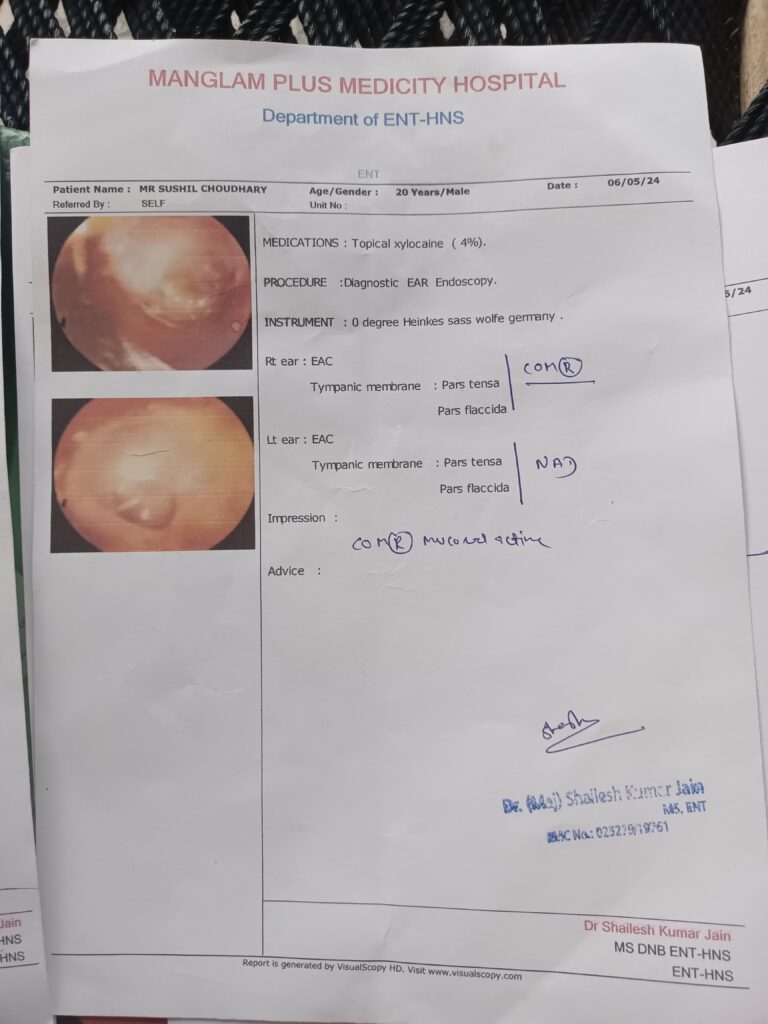
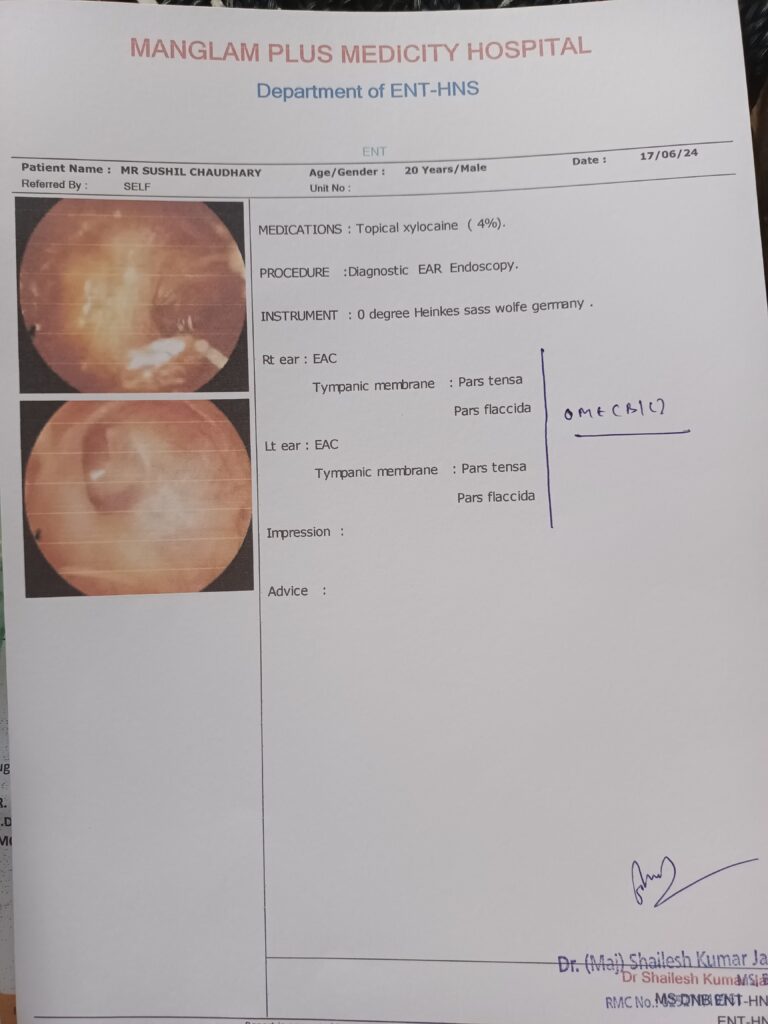
Dr prescription for Ruptured EarDrum
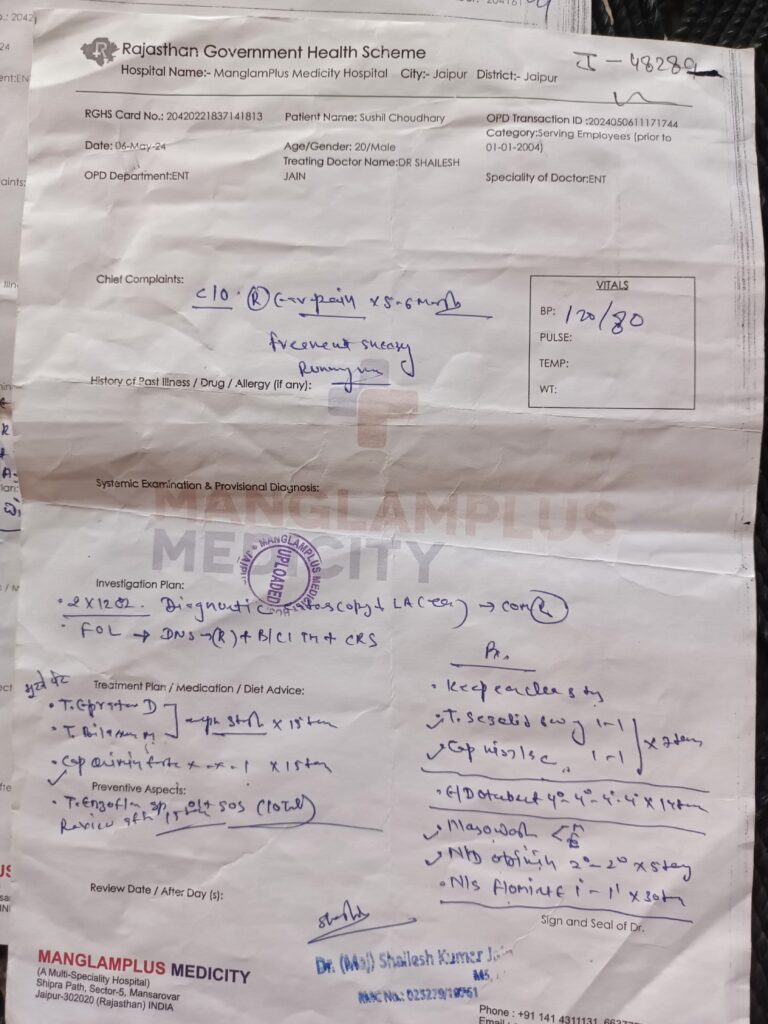
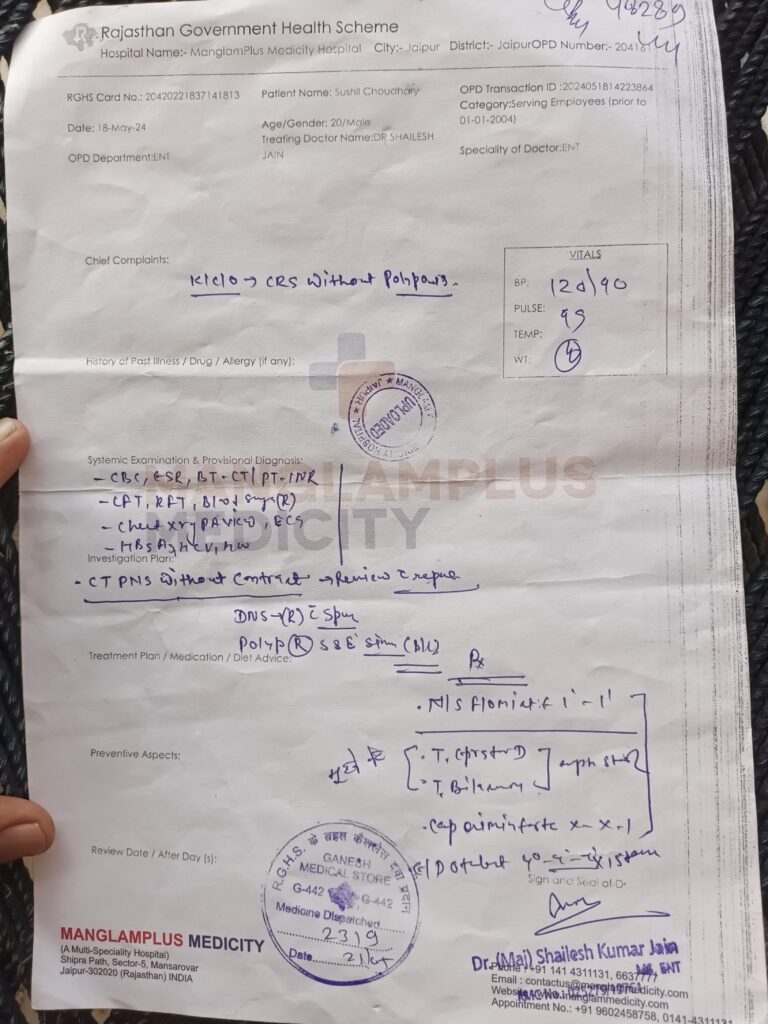
Basic Anatomy of the Ear
The ear is divided into three main parts:
- Outer Ear:
- Pinna (Auricle): The visible part of the ear that collects sound waves.
- Ear Canal (External Auditory Canal): The tube through which sound waves travel to reach the eardrum.
- Middle Ear:
- Eardrum (Tympanic Membrane): A thin membrane that vibrates in response to sound waves.
- Ossicles: Three tiny bones (malleus, incus, and stapes) that transmit sound vibrations from the eardrum to the inner ear.
- Eustachian Tube: A tube that connects the middle ear to the back of the nose and helps equalize pressure.
- Inner Ear:
- Cochlea: A spiral-shaped organ that converts sound vibrations into electrical signals.
- Vestibular System: Involved in balance.
What Happens When the Eardrum Ruptures
When the eardrum ruptures, the following can occur:
Hearing Loss: The ability of the eardrum to vibrate properly is compromised, leading to a reduction in hearing. The degree of hearing loss depends on the size and location of the perforation.
Pain and Discomfort: There can be sudden, sharp pain in the ear, though some people might not feel any pain at all.
Drainage: Fluid, such as clear fluid, pus, or blood, may drain from the ear as a result of the rupture.
Infections: The middle ear becomes more susceptible to infections (otitis media) since the natural barrier provided by the eardrum is breached. This can lead to additional symptoms like fever, increased pain, and further hearing loss.
Vertigo: In some cases, if the inner ear is affected, there can be a sensation of spinning or dizziness due to disturbances in the vestibular system.
Symptoms of a Ruptured Eardrum
Common Symptoms
Pain: Sudden and severe ear pain is a common initial symptom. The pain might subside quickly after the rupture.
Hearing Loss: Partial or complete hearing loss in the affected ear can occur. The degree of hearing loss can vary depending on the size of the perforation.
Discharge: Fluid drainage from the ear, which may be clear, pus-filled, or bloody.
Tinnitus: Ringing, buzzing, or other noises in the ear.
Vertigo: A spinning sensation or dizziness, which can sometimes be accompanied by nausea or vomiting.
Severity of Symptoms
- Mild to Moderate Pain: Pain is usually sharp and intense initially but may decrease rapidly.
- Hearing Loss: This can range from mild to severe, depending on the extent of the damage.
- Discharge: The presence and type of discharge can indicate the severity and type of infection if present.
- Tinnitus and Vertigo: These symptoms can vary in intensity and may indicate inner ear involvement.
When to Seek Medical Help
Severe Pain: If the pain is severe, persistent, or associated with other symptoms like swelling or redness around the ear.
Significant Hearing Loss: Any noticeable or sudden hearing loss should be evaluated by a healthcare professional.
Persistent Discharge: If fluid continues to drain from the ear for more than a few days, or if it is foul-smelling or pus-like.
Tinnitus: Persistent ringing or buzzing in the ear warrants medical evaluation.
Vertigo: If you experience severe dizziness or balance issues, especially if accompanied by nausea or vomiting.
Signs of Infection: Symptoms like fever, swelling, redness, or increasing pain around the ear could indicate an infection requiring medical treatment.
Emergency Situations
Seek immediate medical attention if:
- The ear pain is accompanied by a high fever, severe headache, or confusion.
- There is significant blood discharge from the ear.
- You experience sudden, severe hearing loss or vertigo.
Causes of a Ruptured Eardrum
A ruptured eardrum, also known as a perforated tympanic membrane, can occur due to various reasons. Here are some common causes:
- Infection: Middle ear infections (otitis media) are a frequent cause, especially in children. The infection can cause fluid buildup and increased pressure in the middle ear, leading to a rupture.
- Barotrauma: Rapid changes in air pressure, such as during air travel, scuba diving, or a direct blow to the ear, can cause a pressure imbalance that may result in a ruptured eardrum.
- Loud Noises: Sudden, loud noises like explosions or gunshots (acoustic trauma) can cause the eardrum to rupture.
- Foreign Objects: Inserting objects like cotton swabs, hairpins, or other items into the ear canal can accidentally puncture the eardrum.
- Head Trauma: Severe head injury or trauma to the ear can cause the eardrum to tear.
- Sudden Impact: A sharp blow to the ear, such as being slapped or hit, can cause the eardrum to rupture.
- Chronic Ear Conditions: Chronic ear infections or conditions that cause long-term inflammation or fluid buildup in the middle ear can weaken the eardrum, making it more susceptible to rupture.
- Rapid Altitude Changes: Quick altitude changes without equalizing ear pressure, common in activities like mountain climbing or riding in elevators, can also lead to barotrauma and potential rupture.
Diagnosis
- How doctors diagnose a ruptured eardrum (otoscope examination, hearing tests).
- Possible additional tests (tympanometry, audiometry).
Medical Treatments
- Antibiotics:
- Oral Antibiotics: If the rupture is due to an infection or there’s a risk of an infection developing, doctors may prescribe oral antibiotics.
- Antibiotic Ear Drops: These may be used if the ear is draining to prevent or treat an infection.
- Pain Relievers:
- Over-the-Counter Pain Relievers: Medications like acetaminophen (Tylenol) or ibuprofen (Advil, Motrin) can help alleviate pain.
- Prescription Pain Relievers: In cases of severe pain, a doctor might prescribe stronger pain medications.
- Ear Drops:
- Steroid Ear Drops: These might be prescribed to reduce inflammation and pain.
- Antibiotic Ear Drops: These can help prevent or treat infection if there is discharge from the ear.
Home Care and Self-Care Tips
- Keeping the Ear Dry:
- Avoid Water: Do not let water enter the ear canal. Use a waterproof earplug or cotton ball coated with petroleum jelly when showering or bathing.
- Swimming: Avoid swimming until the ear has healed completely.
- Avoiding Certain Activities:
- Blowing the Nose: Avoid forcefully blowing your nose, as this can increase pressure in the ear and worsen the rupture.
- Flying and Diving: Avoid air travel and scuba diving until the ear has healed, as changes in pressure can aggravate the condition.
- General Care:
- Rest: Adequate rest can help the body heal more efficiently.
- Elevate Head: Sleeping with the head elevated can reduce discomfort.
When Surgery Might Be Necessary
- Tympanoplasty:
- Chronic Perforation: If the eardrum does not heal on its own after a few months or if there is a significant hearing loss or recurrent ear infections, surgery may be needed.
- Procedure: Tympanoplasty involves grafting a small patch of the patient’s own tissue to close the perforation. It is usually performed under general anesthesia.
- Recovery: Recovery involves keeping the ear dry and avoiding strenuous activities for a few weeks. Follow-up appointments are necessary to monitor healing.
- Other Surgical Interventions:
- Myringoplasty: A less extensive procedure than tympanoplasty, used for smaller perforations.
- Ossiculoplasty: If the bones in the middle ear are damaged, a surgeon might repair or replace them during surgery.
Preventing a Ruptured Eardrum
To avoid a ruptured eardrum:
- Use ear protection in loud environments.
- Avoid inserting objects into your ears.
- Equalize ear pressure during altitude changes.
- Wear protective gear during activities prone to head injuries.
Importance of Prompt Ear Infection Treatment
Treating ear infections promptly:
- Prevents fluid buildup that can lead to rupture.
- Reduces pain and discomfort.
- Protects long-term hearing health.
Tips for Maintaining Ear Health
Maintain ear health by:
- Regular checkups with a healthcare provider.
- Keeping ears dry after swimming or bathing.
- Managing allergies and colds promptly.
- Practicing good hygiene and avoiding smoking.
Conclusion
In summary, preventing a ruptured eardrum involves taking proactive steps such as using ear protection in noisy environments, avoiding ear trauma, and treating ear infections promptly. These measures are crucial to maintaining ear health and preventing complications like hearing loss.
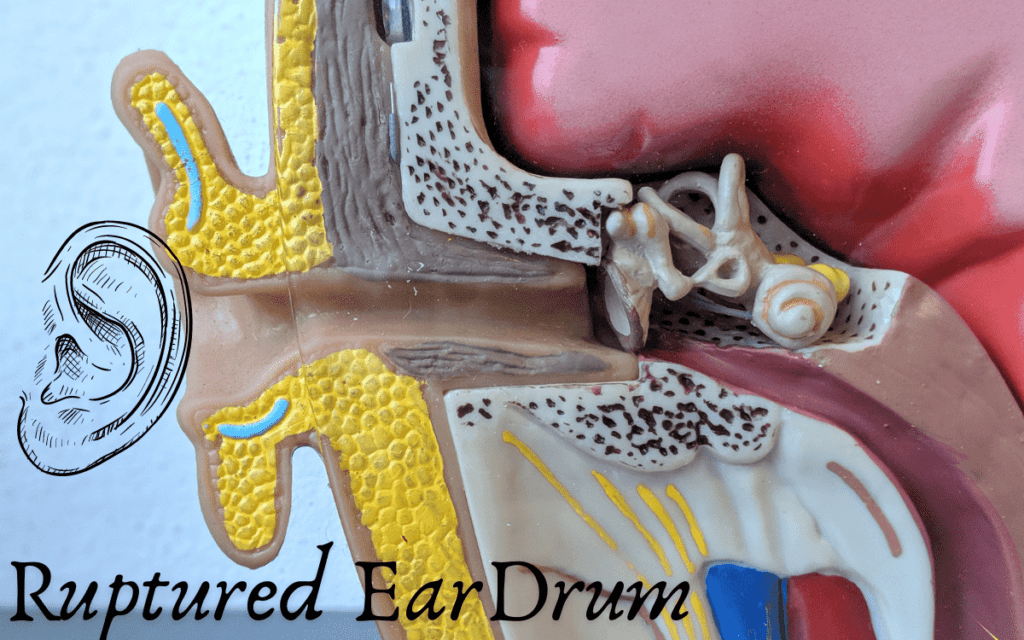
Nice blog 👌